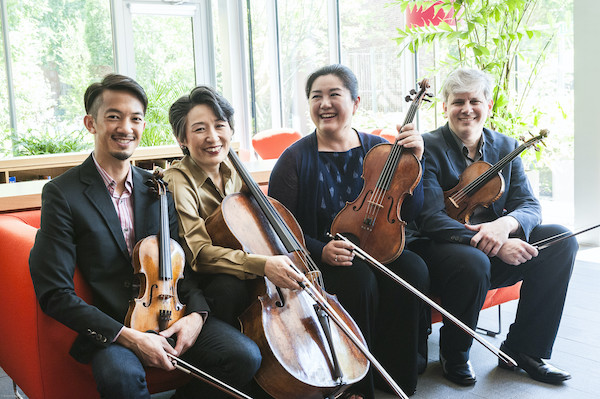Borromeo Quartet explores Beethoven and his forebears for Candlelight Concerts

Candlelight Concert Society concluded a two-day mini-festival honoring Beethoven’s upcoming birthday. After Friday night’s live broadcast by the Gryphon Trio, the Borromeo String Quartet appeared Saturday night in a free streamed concert recorded earlier in Boston. The program explored the musical sources behind Beethoven’s fugal movements, pairing String Quartet No. 13 and its original finale, now known as the Grosse Fuge, with fugues that inspired them.
Imagine if a time traveler one year ago had been shown a video of this concert—and was baffled why the four musicians were playing in masks. The quartet performed in what looked and sounded like a medium-sized room in a house, in front of an abstract painting. The sound captured was not always ideal, especially in the bass range, tending toward weak and muddy at loud dynamics.
The group attacked the opening work, Mozart’s Adagio and Fugue in C Minor, with considerable force. This fugue, with a subject akin to many of Bach’s minor-mode fugues, was the most important model for Beethoven’s Grosse Fuge, as first violinist Nicholas Kitchen explained in one of his many diverting commentaries offered between pieces, complete with musical examples played on his instrument.
Fugues played by a small instrumental ensemble are fascinating, in that they allow such a clear delineation of the intertwining voices. The more hushed parts of Mozart’s Adagio movement, brief but affecting, were warm and balanced, while the forceful playing in the fugue sometimes was distorted in the small room.
Much the same could be said of Bach’s Prelude and Fugue in C sharp minor from the first book of The Well-Tempered Clavier. This prelude worked exceptionally well for string quartet, expressive and infinitely varied in phrasing. Cellist Yeesun Kim and violist Mai Motobuchi were the first two voices heard in this fugue, striking a more somber tone than Mozart’s example. The ear could trace the contrapuntal lines with pleasing clarity, especially with Kitchen and second violinist Kristopher Tong seated across from one another, bringing both top parts to the fore.
Both this fugue and the ensuing Fugue in B Minor, also from Bach’s WTC first book, have subjects similar to Beethoven’s in the Grosse Fuge, with half-step intervals arranged in a rising pattern. That chromatic character lends itself to musical expression, heard especially in the plangent tone of Motobuchi’s viola.
Other elements of this fugue also stuck with Beethoven, including the floating, ornamented suspensions that recur in most of the fugue’s episodes. Bach’s subject ends with a distinctive half-note trill, also important in Beethoven’s Grosse Fuge. Although Bach only wrote the trill on the first statement of the subject, most pianists add it to almost every statement of the subject and answer, a precedent for some reason not followed in this arrangement for string quartet.
This didactic introduction to Beethoven’s models elucidated the group’s fierce interpretation of the Grosse Fuge. The motifs heard in the earlier music popped out of Beethoven’s often dense thicket of sound. Each musician contributed ideal sound and supported one another as lines vied for attention. Kitchen’s musical guidance to the elements not inspired by Bach also helped the listener find his way through this lengthy and convoluted work.
The concert concluded with a visionary rendition of Beethoven’s String Quartet No. 13, in the revised version with Beethoven’s lighter alternate final movement. The sound issues for some reason seemed less pronounced in this work, beginning with the gorgeous, glowing sound of the Adagio introduction to the first movement. In the Allegro section as well, the musicians calibrated their parts with greater awareness, resulting in fewer distortions.
A quicksilver second movement darted and halted in the middle section, and Kitchen’s impeccable intonation and plaintive tone illuminated the third movement’s searing lyricism. The German-style dance of the fourth movement had an unvarnished, homey quality. This contrasted with the mellifluous beauty of the sublime Cavatina, now indubitably the high point of the quartet with the Grosse Fuge replaced by the new, almost jocular finale.
Technical issues made the attempted intermission feature, a video chat by the musicians with Bryan Young, president of Candlelight Concert Society, impossible to understand. These things happen in livestreams, but happily the music came through loud and clear.
Candlelight Concert Society presents pianist Marc-André Hamelin in a recital 3 p.m. January 17. candlelightconcerts.org
